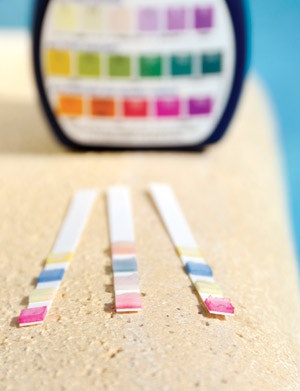
Late in 2012, AQUA reached out to leaders in the water-testing industry for their perspectives on the products consumers and professionals use to determine water-treatment needs.
We were interested in finding out the key factors that drive consumers and professionals to one type of testing method over another, the impact that automated chemical treatment has had on the testing industry, how concerns over waterborne diseases have impacted water testing and finally, the role that in-store lab tests have had on the retail and service markets.
Our interviewees included: Patricia A. Fitzgerald, vice president, marketing, Taylor Technologies; Richard LaMotte, vice president of sales, LaMotte; Teresa Swanson,project and product manager, Hach Company/ETS; and Joe DeFuria, brand manager, BioLab Pro Dealer Division.
The following excerpts those discussions:
What are the key factors driving user product choices?
Fitzgerald: With the exception of health officials, the majority of people who do water testing — industry professionals or consumers — say the most important aspect is how long it takes to run the tests. “Fast” is everything. Close behind that is “cheap.” Not “value for the money,” or even “inexpensive relative to what’s at stake” — be that a business reputation or the monetary investment in the pool or spa.
Ensuring the health of swimmers ought to be the most important thing, followed by protecting the vessel surfaces and equipment from damage. You can’t treat water properly if the test results are faulty. If it takes five minutes to run a battery of tests, it’s time well spent. So at Taylor, while we have to pay attention to our customers when they want “fast,” we won’t do it at the expense of “accurate.”
LaMotte: It’s very different between homeowners and service technicians. From the consumer side, they’re generally looking for things that are affordable, convenient, fast and lastly accurate. That can be the exact reverse of what you find in the professional market, but consumers want something that’s probably under 10 dollars, quick and easy.
Homeowners are concerned with two aspects: They want the water to be safe and clean and second, they want to make sure the water isn’t scaling or corrosive so they don’t incur costs replacing equipment. That’s why sanitizer and pH testing are the foundation for consumers.
Service technicians differ from homeowners in that they are more concerned with accuracy and are generally less concerned that the product be inexpensive. And they obviously are going to want the ability to test for a broader range of parameters — total alkalinity, calcium hardness, total dissolved solids and cyanuric acid levels.
Swanson: Our market research has shown that consumers generally look for products that are easy to use, fast and lastly accurate. Accuracy comes in third because it’s implied that the product will be accurate. Consumers want something that isn’t messy and doesn’t require a great deal of instruction. Consumers tend to be interested in the four-in-one basic test, sanitizer, pH, total alkalinity and cyanuric acid.
The service technician market is different in that precision is far more important. For example, they’ll want to be able to test for total alkalinity and come away with an accurate ppm reading. They are likely looking for more expensive equipment that is durable and reliable. The professional is interested in a wider variety of parameters because they’re going to be troubleshooting. Tests for things like nitrates and phosphates are used predominantly by professionals who might be trying to figure out a chlorine demand problem.
When we introduced our electronic reader, which reads the results digitally, service pros using that product told us that during the 15 to 20 second countdown while the reader is doing its work, they can multitask and do other things. Even though that’s just a few seconds, when you add it up during the course of the day, they can get more pools done. One technician I know said that he could service one more pool each day because of the time he gains multitasking when using the system.
DeFuria: Homeowners are concerned with convenience and speed, which is where test strips are so popular. Within a very few seconds they can determine pH or chlorine levels and know if they need to change what they’re doing. I think the majority of consumers won’t say it’s because they’re interested in becoming a backyard chemist.
That’s where the in-store lab testing comes into play. The retailer becomes the backyard chemist on the homeowner’s behalf. It takes the work of precise testing out of the consumers’ hand. The consumer can then have faith in how their water is going to look and how it’s going to feel.
Certainly most service technicians have their own reagent kit where they can determine key parameters in the field. Many do, however, bring samples into stores for precise analysis, so it becomes a mixture of on-site testing and analysis in the store for the more detailed and in-depth testing. The lab tests do test for a suite of things that don’t change that rapidly, the consumer might take a sample in every four to six weeks or if they’re experiencing water loss and the replacement water is changing the chemistry.
How has the advent of automated testing, i.e., pH and ORP controllers, impacted your business?
Fitzgerald: Some of Taylor’s biggest boosters are controller manufacturers. They recognize manual testing is a necessary adjunct to automation to crosscheck system performance. Moreover, health codes governing many commercial pools and spas often specify that automated equipment be calibrated with a test kit to assure unit performance. Selling reagents for colorimetric automated systems is an opportunity for us, as well.
LaMotte: When you look at pH and ORP controllers, most of those go on public pool installations. It’s true that once you have one of those systems, you can reduce the testing frequency, but you still have to confirm the system’s accuracy with a traditional test kit.
Public health codes often require that you maintain a specific free chlorine residual, and that requires a DPD test because ORP doesn’t test for residual. In situations where you have sudden high bather loads, you might see the ORP suddenly drop and the only way to know the residual level is with a standard reagent test.
Overall, we’ve found that reagent drop tests really work hand in hand with automated systems.
Swanson: You always want to have a backup testing method with those systems. ORP measures the oxidation-reduction potential, which is an indirect method of testing for sanitizer levels. You still want to be able to test for free chlorine levels to be sure it’s in the right range. ORP measures electrical potential reaction while measuring hypochlorous acid is a chemical reaction, so you’re measuring using different things.
Have today’s concerns about waterborne diseases had any impact on marketing or product development?
Fitzgerald: We pay attention to what the industry-accepted guidelines are for key chemical parameters. For instance, the upper end of the recommended ranges for chlorine and bromine are trending upward, the upper end of the recommended range for cyanuric acid is trending downward. Our test ranges have to keep pace.
LaMotte: We had to make an adjustment back in the late ’80s because, for example, the state of New Jersey established specific guidelines for dealing with fecal accidents. There they required that you have to shock the water with a residual over 10 ppm. At that level, DPD tests produce an extremely saturated color that can be tough to read. We did have to make adjustments so that service techs could get reliable readings — that was a big leap.
By contrast with the advent of ozone and other types of systems designed to operate at lower chlorine residuals, say .5 ppm, we had to make adjustments in that direction to generate accurate readings at very low levels. So in effect, we’ve been pushed in two different directions.
DeFuria: I think every time there’s an outbreak in a given area, it raises awareness and you might see an increase in people bringing in samples. I don’t think that has a lasting effect, however. From an education standpoint, we promote the need for routine sanitation, which of course is aimed at keeping people safe from various diseases. That’s where routine water testing comes into play, to protect against those illnesses.
How has the advent of in-store testing labs played into the way people approach testing?
Lamotte: Probably the biggest thing that’s driven in-store lab development has been the influence of mass merchandisers in the market who came into the market in the ’80s selling chemicals at bargain basement prices.
When that started happening, pool and spa retail dealers were freaking out wondering how they could possibly compete. What’s happened is the in-store labs have gone from being primarily a troubleshooting tool to being offered as a free service that draws consumers into the store. Now you have lines in stores of homeowners waiting to have their water tested. I’ve even heard stories of some stores setting up signage that says “30 minutes from this point.”
Dealers realized that not only are people coming into the stores, they’re also telling them what size pool they have, what type of filter system, what type of surface they have and all sorts of other information specific to their pool or spa. Now, all of a sudden, the labs become a wonderful data-collecting tool.
That enabled retailers to fine tune their marketing efforts using the information. If, for example, they’re selling some type of new filtration media, they could do a mailing to those customers using XYZ type of filtration.
DeFuria: For our industry, the primary things that separate our specialty retailers from mass merchants are water testing and collectively, the greater level of knowledge. That knowledge means everything from water treatment to equipment concerns such as replacement parts.
A visit to the store, for whatever reason, definitely leads to impulse purchases such as a float or a pair of goggles.
Because our system can store an infinite number of tests, it can be used as a way to spot trends. If a homeowner has an outbreak of algae every year in August, perhaps because they go on vacation, retailers can spot that trend and contact those customers pre-emptively.
One of the big advantages is the database aspect of the testing. You have the ability to run reports to see which customers have visited the store who have algae in the water, for example. That becomes a perfect follow-up opportunity. You can have staff place follow-up calls to be sure that the water has cleared. It’s also a way to track who hasn’t been in a long time and reach out to those clients to see perhaps if the home has changed hands.
It also comes into play if there’s a warranty issue with a piece of equipment to track the history to confirm that the water has been properly maintained. That’s an example of how the lab becomes a shared platform for homeowners, service people and builders.
Comments or thoughts on this article? Please e-mail [email protected].







































